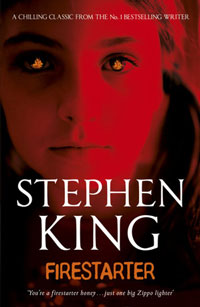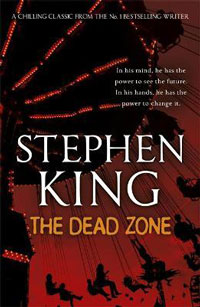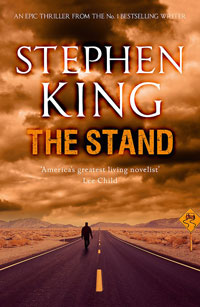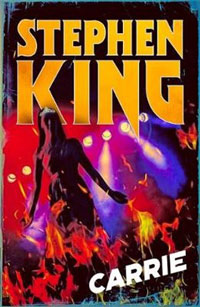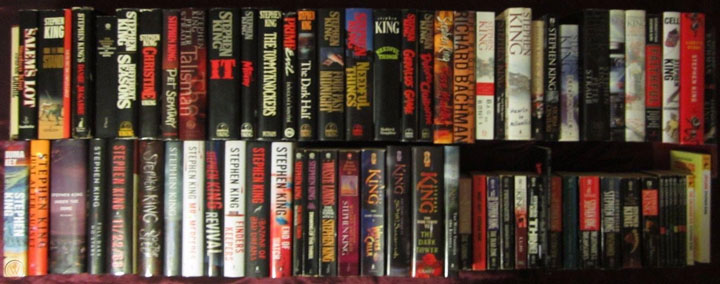(March 17 – April 11)
Reading The Stand while the world continues to deal with a real-life pandemic is certainly a choice. King gets a lot of mileage out of otherwise innocuous coughs and sneezes, which we readers quickly learn are signalling an inevitable death several pages further along. As such, there were plenty of occasions over the past month where the sound of nearby coughs or sneezes had me wondering: “Covid? Captain Trips…? Nothing to worry about? Are you sure??!!”
Fun times.
I’m not alone in including The Stand among the ranks of a select few novels that I like to revisit occasionally, but it’s been quite some time since I last delved into its pages. Inevitably, one of the things that I can’t get over while reading it as part of this project is that it’s only his fourth novel. We’re not even close to the teens of King’s career and already we’ve come to one of his most revered novels. Undoubtedly there are still highlights yet to come, but it’s hard not to see this as a significant peak of King’s career.
And at such a young age …
With the sequence of King’s novels in mind, I also caught myself trying to figure out how we get from The Shining (a relatively self-contained tale) to something as sprawling and ambitious as The Stand. Certainly there are some threads leading into it from earlier works: the large cast of characters from Salem’s Lot; the sense of looming evil from The Shining; the religious angle from Carrie. There’s also a nice nod to The Shining whereby a character has the same telepathic gift as Danny (and it even gets referred to as ‘the shine’ at one point). Otherwise we have a seemingly unfathomable leap forward in King’s bibliography.
There are some additional clues hidden in the forewords / author’s notes to his previous novels. Salem’s Lot is inspired by Dracula. The Shining is inspired by classic haunted house tales such as the Haunting Of Hill House. The Stand is (openly) King’s attempt to do a modern American version of Lord Of The Rings. Perhaps the scope of the book was simply determined by the goal.
On the subject of scope, I am, of course, discussing the expanded edition here (released in 1990 and slightly updated from the original 1978 edition) but as far as I’m concerned this still counts as his fourth published novel given it’s (more or less) the version he would have released had his publishers not insisted on making him cut 400 pages the first time around.
And it’s hard to imagine the novel now without those 400 pages. There’s no sense that the book is overly padded (despite a slightly meandering middle section). Every character King has crafted is vivid and distinct, and getting to spend more time in their company is absolutely a bonus. I have to give special mention to good old Harold Lauder, who remains one of the most fascinating, compelling, tragic and occasionally grotesque characters that King has ever created. Perhaps more than any of the other main characters, it’s Harold’s story that helps make The Stand such a page-turner.
It’s not all flawless, however. Like many King novels the ending is … something that happens at the end of the book. The novel wraps up in a perfectly satisfying way, but I’ve always found the way that the central narrative concludes to be … I don’t know. Convenient? Eccentric? Abrupt? Unconventional? It’s a curious one. Not a bad ending in the same way as It, but certainly one to ponder.
It also has to be said that this is, of the four King novels I’ve reread to date, the one that has made me cringe the most. In particular, one character being repeatedly described as retarded plunges the novel thoroughly into the uninformed past (slightly mitigated by another character objecting to the term ‘retard’). There is also some potential, albeit mild, homophobia. And you can’t read The Stand without concluding that King has quite the obsession with breasts; it may well be my personal reading, but I don’t believe any male body parts get the same degree of attention. I suspect if I read the novel again with a more critical eye, I’d also come away finding that almost all of the female characters (however strong and otherwise well-crafted they are) are predominantly in the shadow of the male characters (think, here, about Nadine’s function in the story, for example).
Otherwise, I think the most notable thing about The Stand is that it’s not actually a horror novel. It undoubtedly has horrific moments, but it’s our first example of King simply telling a good, dramatic tale and not worrying too much about what genre it sits in. Of course, he won’t shake that horror label so easily.
The Adaptations
Not including the comic (which I’ve not read) there are two main adaptations of The Stand: the 1994 miniseries, and the more recent miniseries. Both are perfectly good, but neither (in my opinion) quite does the novel justice.
The 1994 version, while a game attempt, is hampered both by network prurience and the limitations of 1990’s era television visual effects. It’s about as good as it could have been for the time, and Gary Sinise in particular is perfectly cast as Stu Redman. I will definitely have to give it a rewatch sometime soon.
The recent CBS miniseries is actually the inspiration for this King Revisited project—watching it made me want to reread the novel, but I wasn’t convinced I’d have the reading discipline to get through it, so I figured I start with some shorter novels first.
There’s a lot to like about the new adaptation: the casting, for one thing, is pretty much perfect across the board (Owen Teague absolutely knocks it out of the park as Harold). It looks great, as most major TV productions do these days, and there are some efforts to freshen up the plot a little by going for a non-linear structure.
There are some things that didn’t work so well for me. As with the novel there’s a fair bit of dawdling in the middle, and things rush a bit towards the end. I’m also not quite convinced by Flagg’s Vegas here: the horror of it all is far more subtle in the novel, whereas it’s all on the surface here (Nadine’s corpse-like appearance near the end is just one example of the series being way too on the nose). I feel there was a missed opportunity to play a bit more on the “wait, these people are just like us” angle which is hinted at in the novel.
So, as good as it was, I’ll continue to wait (probably forever) for the adaptation that truly does The Stand justice.
The Reading Experience
I vividly remember my first time reading The Stand. I was in an airport waiting to board a flight to the Seychelles (lucky me!) and I needed a book to read. I had a few King novels under my belt by then (summer of 1986) and when I saw The Stand sitting on a carousel in the airport bookshop I figured I was ready for the big leagues.
I have no idea how much of it I read on the plane, but I still remember meeting Trash Can man for the first time; I remember Lloyd being stuck in his prison cell; I remember the trip-trap sound of Randall Flagg’s with boot heels. I may well have spent the entire flight reading.
(As a side note I also remember with equal vividness my fear upon seeing how damn short the runway at our destination was – literally a strip cut into the side of one of the islands, with both ends seemingly running right into the ocean. How we landed safely I’ll never know. I guess these pilots know what they’re doing.)
As I mentioned, I’ve read this novel several times over the ensuing years (most of those times being the expanded edition) but I was somewhat anxious about tackling it again. My reading discipline has declined over the last decade or so. Attempted re-reads of both The Shining and It have stalled and I wasn’t convinced I could make it through The Stand.
So I decided to ease into it …
Maybe it’s something to do with reading physical paperbacks once again, but I didn’t stumble once on this reading. Sure it took me a month to read, but I read consistently. Even the sections I previously found a bit of a drag (most of Frannie and Larry’s backstories) kept me perfectly engaged. The bits I remembered well I was able to enjoy from a whole new perspective; details I had either missed or forgotten came to the fore.
The short version is I was able to enjoy The Stand all over again.
Coming next: There’s a signpost up ahead … next stop: The Dead Zone
